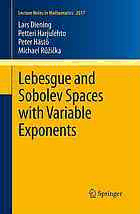Table Of ContentLecture Notes in Mathematics 2017
Editors:
J.-M.Morel,Cachan
B.Teissier,Paris
Lars Diening Petteri Harjulehto
(cid:129)
Peter Ha¨sto¨ Michael Ru˚zˇicˇka
(cid:129)
Lebesgue and Sobolev Spaces
with Variable Exponents
123
LarsDiening PeterHa¨sto¨
LMUMunich UniversityofOulu
InstituteofMathematics DepartmentofMathematicalSciences
Theresienstr.39 Oulu
80333Munich Finland
Germany peter.hasto@helsinki.fi
[email protected]
PetteriHarjulehto MichaelRu˚zˇicˇka
UniversityofHelsinki UniversityofFreiburg
DepartmentofMathematicsandStatistics InstituteofMathematics
Helsinki Eckerstr.1
Finland 79104Freiburg
petteri.harjulehto@helsinki.fi Germany
[email protected]
ISBN978-3-642-18362-1 e-ISBN978-3-642-18363-8
DOI10.1007/978-3-642-18363-8
SpringerHeidelbergDordrechtLondonNewYork
LectureNotesinMathematicsISSNprintedition:0075-8434
ISSNelectronicedition:1617-9692
LibraryofCongressControlNumber:2011925547
MathematicsSubjectClassification(2011):46E30,46E35,26D10,31B15,35J60,35Q35,76W05,
76A05,35B65,35D05
(cid:2)c Springer-VerlagBerlinHeidelberg2011
Thisworkissubjecttocopyright.Allrightsarereserved,whetherthewholeorpartofthematerialis
concerned,specificallytherightsoftranslation,reprinting,reuseofillustrations,recitation,broadcasting,
reproductiononmicrofilmorinanyotherway,andstorageindatabanks.Duplicationofthispublication
orpartsthereofispermittedonlyundertheprovisionsoftheGermanCopyrightLawofSeptember9,
1965,initscurrentversion,andpermissionforusemustalwaysbeobtainedfromSpringer.Violations
areliabletoprosecutionundertheGermanCopyrightLaw.
Theuseofgeneral descriptive names, registered names,trademarks, etc. inthis publication does not
imply,evenintheabsenceofaspecificstatement,thatsuchnamesareexemptfromtherelevantprotective
lawsandregulationsandthereforefreeforgeneraluse.
Coverdesign:deblik,Berlin
Printedonacid-freepaper
SpringerispartofSpringerScience+BusinessMedia(www.springer.com)
Preface
In the past few years the subject of variable exponent spaces has undergone
a vast development. Nevertheless, the standard reference is still the article
byKova´ˇcikandR´akosn´ıkfrom1991.Thispapercoversonlybasicproperties,
such as reflexivity, separability, duality and first results concerning embed-
dings and density of smooth functions. In particular, the boundedness of
the maximal operator, proved by Diening in 2002, and its consequences are
missing.
Naturally, progress on more advanced properties is scattered in a large
number of articles. The need to introduce students and colleagues to the
mainresultsledaround2005tosomeshortsurveyarticles.Moreover,Diening
gavelecturesatthe UniversityofFreiburgin2005andR˚uˇziˇckagaveacourse
in 2006 at the Spring School NAFSA 8 in Prague. The usefulness of a more
comprehensivetreatmentwasclear,andsowedecidedinthesummerof2006
towriteabookcontainingbothbasicandadvancedproperties,withimproved
assumptions. Two further lecture courses were given by Ha¨st¨o based on our
materialinprogress(2008inOuluand2009attheSpringSchoolinPaseky);
another summary is Diening’s 2007 habilitation thesis.
It has been our goal to make the book accessible to graduate students as
wellasavaluableresourceforresearchers.Wepresentthebasicandadvanced
theoryoffunction spaceswith variableexponentsandapplicationsto partial
differential equations. Not only do we summarize much of the existing liter-
ature but we also present new results of our most recent research, including
unifying approaches generated while writing the book.
Writingsuchabookwouldnothavebeenpossiblewithoutvarioussources
ofsupport.WethankouruniversitiesfortheirhospitalityandtheAcademyof
FinlandandtheDFGresearchunit“NonlinearPartialDifferentialEquations:
Theoretical and Numerical Analysis” for financial support. We also wish to
expressourappreciationofourfellowresearcherswhoseresultsarepresented
and ask for understanding for the lapses,omissions and misattributions that
may have entered the text. Thanks are also in order to Springer Verlag for
their cooperation and assistance in publishing the book.
We thank our friends, colleagues and especially our families for their
continuous support and patience during the preparation of this book.
v
vi Preface
Finally, we hope that you find this book useful in your journey into the
world of variable exponent Lebesgue and Sobolev spaces.
Munich, Germany Lars Diening
Helsinki, Finland Petteri Harjulehto
Oulu, Finland Peter H¨ast¨o
Freiburg, Germany Michael R˚uˇziˇcka
November 2010
Contents
1 Introduction........................................................... 1
1.1 History of Variable Exponent Spaces .......................... 2
1.2 Structure of the Book ........................................... 4
1.3 Summary of Central Results.................................... 7
1.4 Notation and Background....................................... 10
Part I Lebesgue Spaces
2 A Framework for Function Spaces............................... 21
2.1 Basic Properties of Semimodular Spaces....................... 21
2.2 Conjugate Modulars and Dual Semimodular Spaces.......... 29
2.3 Musielak–Orlicz Spaces: Basic Properties...................... 34
2.4 Uniform Convexity .............................................. 42
2.5 Separability ...................................................... 48
2.6 Conjugate Φ-Functions.......................................... 52
2.7 Associate Spaces and Dual Spaces ............................. 57
2.8 Embeddings and Operators..................................... 66
3 Variable Exponent Lebesgue Spaces ............................ 69
3.1 The Lebesgue Space Φ-Function................................ 69
3.2 Basic Properties ................................................. 73
3.3 Embeddings...................................................... 82
3.4 Properties for Restricted Exponents ........................... 87
3.5 Limit of Exponents.............................................. 92
3.6 Convolution*..................................................... 94
4 The Maximal Operator............................................. 99
4.1 Logarithmic Ho¨lder Continuity................................. 100
4.2 Point-Wise Estimates ........................................... 104
4.3 The Boundedness of the Maximal Operator................... 110
4.4 Weak-Type Estimates and Averaging Operators.............. 115
4.5 Norms of Characteristic Functions ............................. 122
4.6 Mollification and Convolution .................................. 127
vii
viii Contents
4.7 Necessary Conditions for Boundedness*....................... 131
4.8 Preimage of the Maximal Operator*........................... 138
5 The Generalized Muckenhoupt Condition*.................... 143
5.1 Non Sufficiency of log-Ho¨lder Continuity*..................... 143
5.2 Class A* ......................................................... 149
5.3 Class A for Variable Exponent Lebesgue Spaces*............. 157
5.4 Class A∞*........................................................ 159
5.5 A Sufficient Condition for the Boundedness of M * .......... 168
5.6 Characterization of (Strong-)Domination* .................... 175
5.7 The Case of Lebesgue Spaces with Variable Exponents*..... 180
5.8 Weighted Variable Exponent Lebesgue Spaces*............... 192
6 Classical Operators.................................................. 199
6.1 Riesz Potentials.................................................. 199
6.2 The Sharp Operator M(cid:2)f....................................... 206
6.3 Caldero´n–ZygmundOperators.................................. 208
7 Transfer Techniques................................................. 213
7.1 Complex Interpolation .......................................... 213
7.2 Extrapolation Results ........................................... 218
7.3 Local-to-Global Results ......................................... 222
7.4 Ball/Cubes-to-John.............................................. 237
Part II Sobolev Spaces
8 Introduction to Sobolev Spaces .................................. 247
8.1 Basic Properties ................................................. 247
8.2 Poincar´e Inequalities ............................................ 252
8.3 Sobolev-Poincar´eInequalities and Embeddings ............... 265
8.4 Compact Embeddings........................................... 272
8.5 Extension Operator.............................................. 275
8.6 Limiting Cases of Sobolev Embeddings*....................... 283
9 Density of Regular Functions ..................................... 289
9.1 Basic Results on Density........................................ 290
9.2 Density with Continuous Exponents ........................... 293
9.3 Density with Discontinuous Exponents*....................... 299
9.4 Density of Continuous Functions*.............................. 305
9.5 The Lipschitz Truncation Method* ............................ 310
10 Capacities.............................................................. 315
10.1 Sobolev Capacity ................................................ 315
10.2 Relative Capacity................................................ 322
10.3 The Relationship Between the Capacities ..................... 331
10.4 Sobolev Capacity and Hausdorff Measure ..................... 334
Contents ix
11 Fine Properties of Sobolev Functions........................... 339
11.1 Quasicontinuity.................................................. 339
11.2 Sobolev Spaces with Zero Boundary Values................... 345
11.3 Exceptional Sets in Variable Exponent Sobolev Spaces ...... 350
11.4 Lebesgue Points.................................................. 352
11.5 Failure of Existence of Lebesgue Points* ...................... 360
12 Other Spaces of Differentiable Functions ...................... 367
12.1 Trace Spaces ..................................................... 368
12.2 Homogeneous Sobolev Spaces................................... 378
12.3 Sobolev Spaces with Negative Smoothness .................... 383
12.4 Bessel Potential Spaces* ........................................ 388
12.5 Besov and Triebel–Lizorkin Spaces* ........................... 392
Part III Applications to Partial Differential Equations
13 Dirichlet Energy Integral and Laplace Equation ............. 401
13.1 The One Dimensional Case..................................... 402
13.2 Minimizers ....................................................... 412
13.3 Harmonic and Superharmonic Functions ...................... 417
13.4 Harnack’s Inequality for A-harmonic Functions............... 421
14 PDEs and Fluid Dynamics ........................................ 437
14.1 Poisson Problem................................................. 437
14.2 Stokes Problem .................................................. 446
14.3 Divergence Equation and Consequences ....................... 459
14.4 ElectrorheologicalFluids........................................ 470
References................................................................... 483
List of Symbols ............................................................ 501
Index ......................................................................... 505

